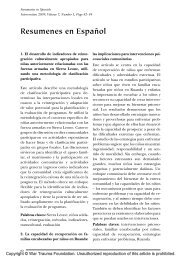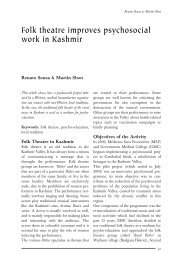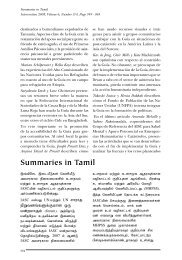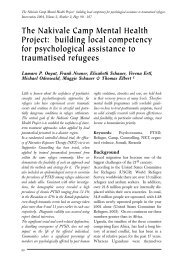The reintegration of teenage girls and young women
The reintegration of teenage girls and young women
The reintegration of teenage girls and young women
Create successful ePaper yourself
Turn your PDF publications into a flip-book with our unique Google optimized e-Paper software.
<strong>The</strong> <strong>reintegration</strong> <strong>of</strong> teen-aged <strong>girls</strong> <strong>and</strong> <strong>young</strong> <strong>women</strong><br />
Intervention 2006, Volume 4, Number 3, Page 219 ^ 228<br />
frontline, inboth Congo- Brazzaville <strong>and</strong>the<br />
Democratic Republic <strong>of</strong>Congo (DRC)<br />
exclusively female units have been in operation.<br />
Girls have been involved in the liberation<br />
struggles in East Timor <strong>and</strong> South<br />
Africa. <strong>The</strong>y have been recruited into the<br />
armed forces <strong>of</strong> the United Kingdom. In<br />
Liberia, <strong>girls</strong> have armed themselves to<br />
avengerape<strong>and</strong>protectthemselves<strong>and</strong>others<br />
fromabuse,<strong>and</strong>arefearedastoughopponents<br />
by male soldiers (Brett & Specht,2004).<br />
Youth<br />
<strong>The</strong> category <strong>of</strong>‘youth in con£ict’ is<br />
currently receiving a lot <strong>of</strong>attention in international<br />
discussions <strong>and</strong> programing, referring<br />
to the group <strong>of</strong><strong>young</strong> people between 15<br />
<strong>and</strong> 24 years <strong>of</strong>age. 1 Young men <strong>and</strong> <strong>women</strong>’s<br />
direct involvement in war is a widespread<br />
phenomenon.This isespecially markedwhen<br />
prolonged wars strip societies <strong>of</strong>their adult<br />
generation <strong>and</strong> therefore, requires armies or<br />
¢ghting forces to resort to <strong>young</strong>er generations<br />
as cheap, e¡ective <strong>and</strong> obedient ¢ghters.<br />
Combined with high rates <strong>of</strong>youth<br />
unemployment <strong>and</strong> inadequate access to<br />
schooling, <strong>young</strong> people are vulnerable to,<br />
<strong>and</strong> <strong>of</strong>ten volunteer for, recruitment.<br />
<strong>The</strong> approach<strong>of</strong>many Disarmament, Demobilization<br />
<strong>and</strong> Reintegration programmes is<br />
inappropriate (Brett & Specht,2004) forboth<br />
sexes in this age group. Those below the age<br />
<strong>of</strong>18 are regarded as child soldiers <strong>and</strong> are<br />
<strong>of</strong>ten automatically treated as children. By<br />
doing this, their ambitions <strong>and</strong> the extended<br />
responsibilities many <strong>of</strong>them have had as<br />
providers (War Child, 2005) are not taken<br />
into account. Those just over 18 are treated<br />
as adults in programmes with a ‘livelihood<br />
focus’ that neglects age-speci¢c needs such<br />
as catch-up education, as well as ignoring<br />
their ambitions for career development. In<br />
fact, the speci¢c quality <strong>of</strong> this group is that<br />
they are neither children nor adults, but have<br />
220<br />
distinct characteristics as a result <strong>of</strong>their<br />
in-between status.<strong>The</strong> period <strong>of</strong>adolescence<br />
is an extremely sensitive <strong>and</strong> dynamic phase<br />
in which people develop their personalities,<br />
world views <strong>and</strong> careers.Young combatants,<br />
therefore, require tailored assistance that<br />
responds to their speci¢c needs <strong>and</strong> ambitions.<br />
In the following, we will focus on some<br />
<strong>of</strong>the issues concerning girl combatants in<br />
DDR processes.<br />
Preconceived ideas about the roles <strong>girls</strong> <strong>and</strong><br />
boys each play in con£ict <strong>of</strong>ten cast the males<br />
as the aggressors <strong>and</strong> the females as the victims.<br />
A more careful examination, however,<br />
reveals a complex dynamic where war is<br />
experienced di¡erently, both between <strong>and</strong><br />
within, the genders. However, girl combatants<br />
dotendtobemorevulnerablethantheir<br />
male colleagues in a variety <strong>of</strong>key ways:<br />
Before the con£ict, which is re£ected in<br />
their reasons for becoming involved;<br />
During the con£ict in which they tend to<br />
be more <strong>of</strong>ten exposed to sexual violence<br />
<strong>and</strong> exploitation 2 ; <strong>and</strong><br />
By having di⁄culties in taking advantage<br />
<strong>of</strong>possible bene¢ts both during the con-<br />
£ict, <strong>and</strong> in post-con£ict reconstruction.<br />
Reasons to join<br />
It is <strong>of</strong>key importance to underst<strong>and</strong> the<br />
reasons why <strong>girls</strong> join the armed forces in<br />
order to be able to provide <strong>reintegration</strong><br />
assistance that will have a signi¢cant longterm<br />
impact. Too <strong>of</strong>ten, neglecting rootcauses<br />
has led to atype <strong>of</strong>self-limiting <strong>reintegration</strong><br />
assistance adhering to super¢cial<br />
aims such as ‘putting families back together<br />
under the same ro<strong>of</strong>’ <strong>and</strong> ‘keeping <strong>young</strong><br />
people o¡ the streets’. E¡ective <strong>reintegration</strong><br />
would have to involve a more serious attempt<br />
to help these <strong>young</strong> people to ¢nd their way<br />
in civilian life. Instead, <strong>young</strong> people <strong>of</strong>ten ¢nd<br />
themselves consigned to environments <strong>of</strong>








